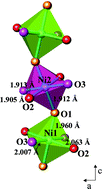The structural changes of polycrystalline DyNiO3 perovskite across the metal–insulator transition (TMI = 564 K) have been studied by high resolution neutron diffraction techniques together with Mössbauer spectroscopy, in a sample doped with 1.5 at.% 57Fe. In the insulating (semi-conducting) regime, below TMI, the perovskite is monoclinic, space group (SG) P21/n, and the crystal structure contains two chemically different Ni1 and Ni2 cations, as a result of the charge disproportionation of Ni3+ cations. The β parameter, characterizing the low-temperature monoclinic distortion, is smaller than 90.04° for T < TMI, indicating a strongly pseudo-orthorhombic symmetry, although the internal monoclinic symmetry, implying the splitting and shifts of oxygen positions around the two Ni sites is perfectly detected by neutrons. Above TMI, DyNiO3 becomes orthorhombic, SG Pbnm. Upon heating across TMI, there is an abrupt convergence of the two sets (Ni1 and Ni2) of three Ni–O bond lengths, in the monoclinic-insulating phase, to three unique Ni–O distances in the orthorhombic-metallic phase upon entering the metallic region. The 57Fe Mössbauer spectra of an iron-doped (1.5 at.%) DyNiO3 sample recorded in the insulating, paramagnetic temperature range (TN < T < TMI) are discussed by supposing that the Fe3+ probe cations replace nickel in the two octahedral Ni1 and Ni2 sites. Electric field gradient calculations have shown that the 57Fe hyperfine parameters of Fe1 and Fe2 subspectra reflect a specificity of local structure corresponding to large (Ni1O6) and small (Ni2O6) octahedra. At T > TMI, the 57Fe spectrum gives clear evidence for the formation of an unique state for iron probe atoms and could, therefore, imply that the charge disproportionation in the (NiO6) subarray completely vanishes at the insulator→metal transition.


 Please wait while we load your content...
Please wait while we load your content...